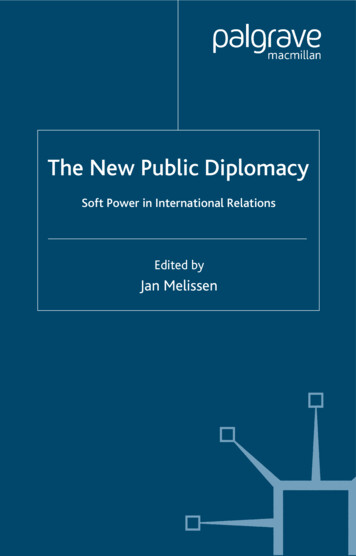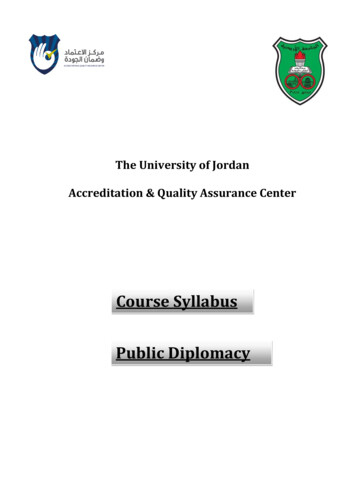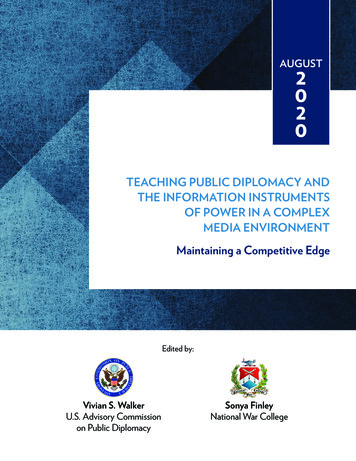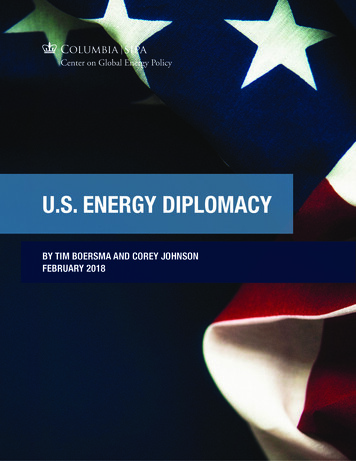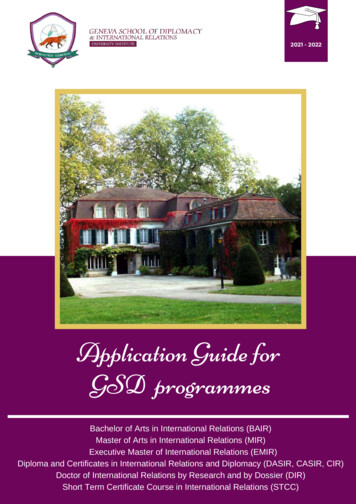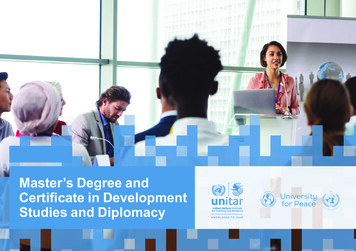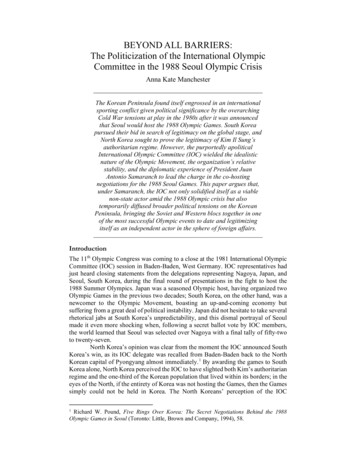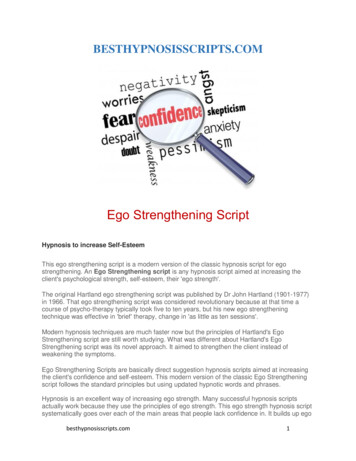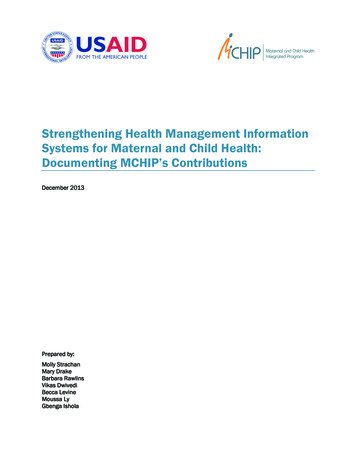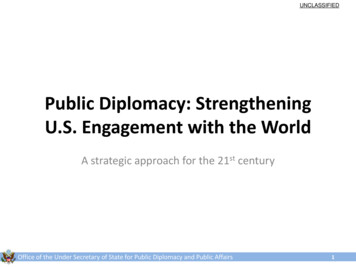
Transcription
UNCLASSIFIEDPublic Diplomacy: StrengtheningU.S. Engagement with the WorldA strategic approach for the 21st centuryOffice of the Under Secretary of State for Public Diplomacy and Public Affairs1
UNCLASSIFIEDPreface: Scope of the Strategic Framework for Public DiplomacyThis strategic framework is intended to be a roadmap for Public Diplomacy,ensuring its alignment with foreign policy objectives, and bringing a strategicfocus to how Public Diplomacy programs, resources and structures supportthose objectives.The framework will serve as the foundation for Public Diplomacy’s FY 2012budget request, but the operating principles herein are intended to guidePublic Diplomacy operations now.The framework is the first phase of a process for developing a detailedstrategic plan for Public Diplomacy. Working groups will start immediately,tasked with working through implementation details for each of the tacticsoutlined herein.Office of the Under Secretary of State for Public Diplomacy and Public Affairs2
UNCLASSIFIEDPublic DiplomacyMission StatementTo support the achievement of U.S. foreign policygoals and objectives, advance national interests,and enhance national security by informing andinfluencing foreign publics and by expanding andstrengthening the relationship between the peopleand government of the United States and citizens ofthe rest of the world.Office of the Under Secretary of State for Public Diplomacy and Public Affairs3
UNCLASSIFIEDThe World We FaceTo meet the challenges and seize theopportunities of the 21st century, we needa foreign policy that uses tools andapproaches to match a changing globallandscape of engagement.Office of the Under Secretary of State for Public Diplomacy and Public Affairs4
UNCLASSIFIED45%10%of globalpopulation isunder 255%12xMillions connectedPercent of populationThe world we face: A changing global landscape of engagementincrease inglobal cellularpenetration inlast decade40new electoraldemocracies inthe past 445-4950-5455-5960-6465-6970-7475-7980-8485-8990 0%AgeDemographics Young people represent aparticularly high stakes andimportant group that has come ofage in a period marked by limiteddirect American engagement Women are 50% of populationbut earn only 10% of income andown 1% of property Illiteracy and low levels ofeducation in conflict areascontinue to impact the dynamicof engagementCommunicationsPeople Power Immediate public access to a widearray of information changes thenature of communications Masses matter: power andinfluence within societies hasshifted from the few to the many Information, misinformation, anddisinformation rapidly penetratedeeply into societies Even in authoritarian countries,people and institutions areincreasingly able to shape thedebate Technology empowers people bybetter connecting them withcommunities, networks, andmarkets Technology can also serve as aspark which ignites discontent,dissent, and destructionOffice of the Under Secretary of State for Public Diplomacy and Public AffairsSources: Population Reference Bureau, Freedom House, United Nations Development Fund for Women Traditional bilateral diplomacycannot address the full range ofactors now engaged on globalissues5
UNCLASSIFIEDThe world we face: Competing influencesA broad and increasingly active set of players is filling the global space forengagement and communications. For example: Extremists have developed sophisticated media strategies and areincreasingly adept at shaping the narrative and recruiting new followers. China’s global influence is increasing through broad outreach programsand expanded Chinese language teaching. Aggressive marketing of higher education opportunities in the EU,Singapore, and Australia has diminished a key appeal of the U.S. for theworld’s best and brightest. Russia’s media presence has expanded in former USSR countries. Iran’s cultural centers and political linkages have created broaderinfluence with key publics.Office of the Under Secretary of State for Public Diplomacy and Public Affairs6
UNCLASSIFIEDThe world we face: Complex global challenges Democracy and human rightsMaking progress on these issues Combating violent extremismrequires complex, multi-dimensional Nuclear non-proliferationpartnerships, mobilize broad coalitions, Economic opportunity and prosperityand galvanize public opinion across allpublic engagement strategies to forgesectors of society: activists and Women’s empowermentacademics, business and civil society Climate change and natural disastersleaders, faith communities and NGOs. Food securityAn effective approach to Global healthPublic Diplomacy is now Outreach to Muslim communitiesmore important than ever.Office of the Under Secretary of State for Public Diplomacy and Public Affairs7
UNCLASSIFIEDStrategic Imperatives for 21st Century Public DiplomacyShape the narrativeDevelop proactive outreachstrategies to inform, inspire,and persuadeWe have been misrepresented—or not represented at all—in toomany global conversations.Expand and strengthenpeople-to-people relationshipsCombat violent extremismBuild mutual trust and respectthrough expanded PublicDiplomacy programs and platformsCounter violent extremist voices,discredit and delegitimizeal Qaeda, and empowercredible local voicesA foundation of trustopens ears and minds.The voices of violent extremistsmust not go unchallenged.Better inform policy-makingDeploy resources in linewith current prioritiesEnsure foreign policy is informedupfront by an understanding ofattitudes and opinionsof foreign publicsStrengthen structures andprocesses to ensure coordinatedand effective Public DiplomacyIf we fly blind,expect to crash.We can do this better and we have to.Office of the Under Secretary of State for Public Diplomacy and Public Affairs8
UNCLASSIFIEDAchieving our objectives: Tactics1Shape the narrativeDevelop proactive outreach strategiesto inform, inspire, and persuadeCurrent challenges Our spokespeople need new tools todeal effectively with the 24/7 realityof new media Inaccurate information often definesstories about America before wehave a chance to shape the debate There is a surfeit of informationabout the U.S.—accurate and not—available to audiences all around theworldOffice of the Under Secretary of State for Public Diplomacy and Public Affairs9
UNCLASSIFIEDAchieving our objectives: Tactics1Shape the narrative: Develop proactive outreach strategies to inform, inspire, andpersuadeRapidly respond to inaccurate information; expand and strengthen capability to proactively and nimblyengage with international media to shape stories Develop and implement country/region-specific targeted media engagement plans to strengthen U.S. ability to shape thenarrative and proactively present U.S. viewsWork with posts to create media engagement plans based on detailed analysis of the environment and target audiences toshape stories early and effectively tailor the content of our messages. Increase operating freedom for frontline staff at post through more flexible and nimble engagement with media andbuild capacity for aggressive, timely responseRevise guidance and clearance processes to equip USG voices to engage quickly with a multitude of online voices and othermedia sources. Empower staff to use centrally produced press guidance without requiring time-consuming clearance. Expand role of Regional Media Hubs, and enhance their capabilities as digital engagement centersEquip Hubs with greater ability to shape regional debate in traditional media and new digital channels. Designate a Deputy Assistant Secretary to oversee international media support within the Bureau of Public Affairs (PA)DAS will support posts in media outreach and coordinate PA’s functions focused on foreign audiences, including foreignpress centers, regional media hubs, rapid response units. Support free and vibrant international media through exchange and engagementIncrease journalistic exchanges and convene global fora for media executives/journalists to encourage responsiblejournalism and the unrestricted flow of information to citizens worldwide.Office of the Under Secretary of State for Public Diplomacy and Public Affairs10
UNCLASSIFIEDAchieving our objectives: Tactics1Shape the narrative: Develop proactive outreach strategies to inform, inspire, andpersuadeExpand ability to leverage traditional and innovative information platforms for shaping global dialogue,communicating U.S. perspectives, and countering misinformation and disinformation Recruit a leader for International Information Programs (IIP) with a deep understanding of behaviors, attitudes andpreferences in international markets; strengthen capacity to analyze target audiences, leverage new technologies, andmanage strategic outreach campaignsIIP will serve as the creative and innovative center of Public Diplomacy, developing strategic campaigns for policy priorities(including Administration priorities such as climate change and food security) based on audience research and analysis. IIPwill develop creative applications for cutting-edge technology to enable posts to better engage with their publics.Ensure that all Department equipment and regulations facilitate the use of new modes of communicationand engagement Upgrade necessary equipment in Washington and at postProvide Posts with up-to-date equipment needed to fully utilize new tools, and put those tools into the hands of all whoneed to be accessible in a 24/7 media environment. These may include updated operating systems, Blackberries, Applecomputers, wireless internet, flashdrives, Flip-cams for recording events, and basic video-editing tools. Standardize practices for access to and use of digital toolsDisseminate clear and coordinated guidance to posts for use of digital tools, such as Facebook or YouTube, to addressconfusion and inconsistency in utilization of new forafor engagement and communication. Allow liberal use of these newmedia and tools within a framework of risk management.Office of the Under Secretary of State for Public Diplomacy and Public Affairs11
UNCLASSIFIEDAchieving our objectives: Tactics2Expand and strengthenpeople-to-peoplerelationships Budget constraints have limited ourability to engage beyond traditionalelites, despite demographic shiftsBuild mutual trust and respect throughexpanded Public Diplomacy programsand platforms Security concerns have shut venuesfor direct engagement, often leavingthe U.S. presence defined byfortified compoundsCurrent challenges Experimentation with new mediatools has been uneven across posts Fast turnover of personnel andlimited follow-up with programparticipants leads to limited returnon investments in skills andrelationshipsOffice of the Under Secretary of State for Public Diplomacy and Public Affairs12
UNCLASSIFIEDAchieving our objectives: Tactics2Expand and strengthen people-to-people relationships: Build mutual trust and respectthrough expanded Public Diplomacy programs and platformsBuild Public Diplomacy programs for 21st century audiences Broaden the demographic base of people with whom we engage, and create comprehensive strategies for critical groupsExpand audiences and program participants beyond traditional elites. Seek mechanisms to encourage a wider circle ofpeople (e.g. rural; less affluent) to participate in programs and visit American venues. Place additional emphasis on reachingcritical demographics, like youth and women, based on extensive analysis of views, values, and opinions in targetgeographies. Strategies will aim to: create long-term relationships with future leaders; amplify credible voices around theworld; and empower these groups to play larger constructive roles within their own societies. Use social networking and connective technologies more effectivelyLeverage new tools to communicate U.S. perspectives where appropriate. Participate in informal dialogues in newconversation spaces. Empower individuals to use these tools to play constructive roles within their own communities.Emphasize programs which advance U.S. national interests and develop desired skills that provideopportunity and alternatives to extremism Expand English language teaching and teacher trainingBroaden English language teaching as a bridge to foreign publics and a tool for economic empowerment. Set bold goals tocapture the imagination of the public as well as attract private sector funding. Encourage collaboration and skill-building in science, technology, and entrepreneurshipEnable knowledge-sharing between U.S. scientists and foreign publics through research, exchanges, teaching, andeducational development; encourage linkages between the lab and marketplace to facilitate economic growth based oninnovation; and increase awareness of U.S.-sponsored science and commercial partnerships. Expand educational advising to provide access to academic opportunityProvide larger network of advisers to connect young people with educational programs in the U.S. to strengthen the imageof the U.S. as a welcoming location for opportunity and advancement. For example, link American university students tothose considering study in the U.S. through social networking technology to complement more formal advising efforts.Office of the Under Secretary of State for Public Diplomacy and Public Affairs13
UNCLASSIFIEDAchieving our objectives: Tactics2Expand and strengthen people-to-people relationships: Build mutual trust and respectthrough expanded Public Diplomacy programs and platformsExpand Public Diplomacy platforms and venues for direct engagement with foreign audiences to present anew face to foreign publics beyond fortified compounds Revitalize and establish American Centers/Corners as spaces for Public Diplomacy activities and engagementIdentify the best means of upgrading and maintaining publicly-accessible, secure American Corners/Centers. Design modelsfor new American Centers as venues for programs beyond fortified compounds and as symbols of our desire to engage.Actively seek private sector partners in making these places showcases for American culture and technology. For example,Embassy Jakarta is developing plans for an American Place in a shopping mall. Reinvigorate cultural programming to drive engagement and collaborationScale up cultural programming that presents American art, theater, music, dance, and literature to create apolitical space forbuilding relationships and to counter negative stereotypes about American culture. Extend American culture’s collectivereach by facilitating the overseas work of other public and private cultural institutions and organizations (e.g. theSmithsonian or regional arts councils), using technologies to multiply linkages (e.g. online arts management courses taughtby U.S. experts or online fora for sharing artistic content), and encouraging artistic collaboration as a springboard forenduring relationships.Sustain enduring relationships and ensure that USG fully leverages investments in relationships and skills Deepen our connections with alumni of USG programs through better long-term outreach programsGreatly expand alumni coordination, tracking, and outreach to turn these potential resources into credible advocates andcommunity organizers. Consider longer or repeat assignments for Public Diplomacy FSOs as appropriateOne- or two-year tours can impede FSOs’ ability to develop deep relationships with host-country contacts. Longer tours (e.g.three or four years where appropriate) or repeat assignments would allow FSOs to better capitalize on country-specificknowledge and language abilities.Office of the Under Secretary of State for Public Diplomacy and Public Affairs14
UNCLASSIFIEDAchieving our objectives: Tactics3Combat violent extremismCounter violent extremist voices,discredit and delegitimize al Qaeda,and empower local credible voicesCurrent challenges Violent extremists have used a widevariety of platforms and media tospread their messages and inspirenew followers We have not developed an effectiveapproach for countering violentextremist propagandaOffice of the Under Secretary of State for Public Diplomacy and Public Affairs15
UNCLASSIFIEDAchieving our objectives: Tactics3Combat violent extremism: Counter violent extremist voices, discredit and delegitimizeal Qaeda, and empower local credible voicesRapidly respond to extremist messages; proactively shape the narrative that has allowed extremists todisseminate misinformation and recruit new followers Aggressively harness new and traditional media to communicate U.S. perspectives and counter misinformationDevelop targeted media engagement plans in key geographies allowing for quick response to those who speak foral Qaeda; expand the role of media hubs and enhance their role as digital engagement centers to play a larger role inregional dialogues; bolster International Information Program’s capabilities to leverage media platforms for participatingin new conversation spaces and disseminating information.Empower credible voices within societies to undermine violent extremists’ messages Provide tools and platforms for independent voices to expand their reachFacilitate linkages between post contacts to create stronger civil society networks to advocate more effectively; provideaccess and training in social media to create broader platforms for local voices; equip post contacts with usefulinformation and resources to deepen their impact Leverage partnerships to train religious and secular leaders with local influence in issues of development, health,and educationExpand programs to work with local leaders to equip them with relevant skills and knowledge for strengthening theircommunities, expanding economic opportunity, and improving living conditions. Enhance the capacity of participatingleaders to: share information on critical topics with members of the communities they serve; act as conduits for relayingcommunity needs and expectations; serve as catalysts for activities in their own communities.Office of the Under Secretary of State for Public Diplomacy and Public Affairs16
UNCLASSIFIEDAchieving our objectives: Tactics4Better inform policy-makingCurrent challengesEnsure foreign policy is informed upfrontby an understanding of attitudes andopinions of foreign publics Public Diplomacy must be more fullyintegrated into foreign policyformulation PD-specific mechanisms foranalyzing our operatingenvironments and linking plans topolicy, like USIA’s institutionalanalysis and country plans, no longerexist Structures for interagencycoordination for Public Diplomacyand Strategic Communication effortsneed strengtheningOffice of the Under Secretary of State for Public Diplomacy and Public Affairs17
UNCLASSIFIEDAchieving our objectives: Tactics4Better inform policy-making: Ensure foreign policy is informed upfront by an understandingof attitudes and opinions of foreign publicsBolster Public Diplomacy’s integration with and role in formulating foreign policy Appoint a Deputy Assistant Secretary dedicated to Public Diplomacy in each regional bureauElevated Public Diplomacy presence within regional bureaus will provide greater integration of Public Diplomacy activity andpolicy formulation and stronger links between R and regional bureaus. It is critically important that the position be filledwith a senior Foreign Service Officer with extensive experience in the region. DAS would lead regional Public Diplomacyoperations.Ensure that market research becomes a critical component of Public Diplomacy strategy Bolster capabilities to conduct and disseminate market and consumer research that tracks and analyzes important trendsin global behavior and opinionEnhance and expand Public Diplomacy’s organizational capacity for thorough research, analysis, and monitoring of audienceopinion and sensitivities to ensure that State maintains a deep understanding of the evolving environment for engagement.Create a staff dedicated to market research and analysis within International Information Programs (IIP) and continue tostrengthen collaboration with the Bureau of Intelligence and Research (INR). Leverage research and analysis to inform foreign policy formulation and tailor outreach to resonate with target audiencesIncorporate research into development of Public Diplomacy strategies and initiatives to ensure that chosen methods forengagement and communications reflect a nuanced understanding of host society opinions, norms, and modes ofcommunication and achieve maximum impact. Ensure that Public Diplomacy’s expertise and understanding of societaltrends informs foreign policy formulation and implementation.Office of the Under Secretary of State for Public Diplomacy and Public Affairs18
UNCLASSIFIEDAchieving our objectives: Tactics4Better inform policy-making: Ensure foreign policy is informed upfront by an understandingof attitudes and opinions of foreign publicsCoordinate proactively with other USG departments and agencies Strengthen the role and capacity of the Global Strategic Engagement Center at StateSupport IPCs for Global Engagement and Strategic Communications, connect decision-makers with Government-wideexpertise and analysis, and alert the interagency to emerging and long-term communications and engagement trends andissues. Establish detail positions for Public Diplomacy officers in DHS, DoD, and USAIDDetail positions and embedding will create closer linkages and improve understanding of partners’ capabilities to better planfor collaborative whole-of-government approaches. Reinforce role of Public Affairs Officers (PAOs) to lead communications and engagement at postSeveral USG agencies conduct activities related to Public Diplomacy. PAOs should be empowered to support, coordinate,and integrate the efforts of all mission elements in external communications and other forms of engagement.Office of the Under Secretary of State for Public Diplomacy and Public Affairs19
UNCLASSIFIEDAchieving our objectives: Tactics5Deploy resources in linewith current prioritiesStrengthen structures andprocesses to ensure coordinatedand effective Public DiplomacyCurrent challenges Annual budgets are largelydetermined by previous yearspending, not by changing globalpriorities The Under Secretary lacksmechanisms to effectivelycoordinate Public Diplomacyoperations Tools for evaluating short- and longterm impact are not uniformly usedor built into planning DoD continues to hold a largeproportion of USG resources forcivilian-focused engagementOffice of the Under Secretary of State for Public Diplomacy and Public Affairs20
UNCLASSIFIEDAchieving our objectives: Tactics5Deploy resources in line with current priorities: Strengthen structures and processes toensure coordinated and effective Public DiplomacyEstablish mechanisms for appropriate allocation of resources to support foreign policy priorities Initiate needs-based and policy-oriented budgeting approach to ensure alignment with current prioritiesReview allocations as part of QDDR process to ensure that resource levels reflect evolving priorities. Institute annualstrategic reviews with regional bureaus and R to ensure that plans and resources support current goals. Establish multi-year Public Diplomacy plans at all posts based on thorough research and analysisReorient Public Diplomacy planning culture to require posts to identify policy objectives and target audiences based oninsights into evolving trends in opinion and behavior. Multi-year plans will help to provide clarity of objectives and ensurecontinuity through personnel turnover. Fully utilize evaluation and assessment tools to measure Public Diplomacy’s impactImprove tracking and reporting mechanisms and incorporate measurement into all Public Diplomacy plans. Use evaluationand measurement results to help focus Public Diplomacy plans on activities designed to maximize impact. Track short-termoutputs to ensure successful program management and to build baseline data and longitudinal data sets to understandlong-term impact on opinions and attitudes. Support innovation and flexibility at post and create a Fund for InnovationCreate a Fund for Innovation to allow posts to pursue innovative ideas for outreach. Funding decisions would be madequickly to ensure that time-sensitive opportunities are not missed or postponed until the next fiscal year budget cycle. Seekadditional mechanisms to provide more flexible budgeting within budget cycles for rapid deployment of funds to timelyinitiatives.Strengthen the Under Secretary’s ability to coordinate Public Diplomacy programs and resources Bolster R’s Office of Policy, Planning, and Resources by strengthening its ability to coordinate global Public Diplomacypolicy, evaluation, and strategic resource allocationStrengthen central functions for Public Diplomacy to ensure that activity flows from strategic priorities and is coherent andcoordinated.Office of the Under Secretary of State for Public Diplomacy and Public Affairs21
UNCLASSIFIEDAchieving our objectives: Tactics5Deploy resources in line with current priorities: Strengthen structures and processes toensure coordinated and effective Public DiplomacyGrow and diversify Public Diplomacy’s private sector partnership base to extend and enrich our reach and toenable State to serve as a catalyst, aggregator and convener of American efforts at engagement Broaden the pool of private sector partners with whom we engageMultifaceted challenges require partners beyond the USG. Public Diplomacy should act as a catalyst and aggregator for nongovernmental efforts at engagement. Partnerships with corporations, foundations, academic institutions, and privatecitizens can broaden Public Diplomacy impact and facilitate deeper linkages between U.S. civil society and counterpartsabroad. Seek private sector funding to share costs of new engagement platformsThe scale of required outreach and budget realities will require Public Diplomacy to secure new sources of support forinitiatives.Begin review with Defense Department and interagency of civilian-focused activities led by DoD Work closely with the interagency and Congress to ensure that any new responsibilities are accompanied by newresources; build internal capacity to successfully absorb any new resourcesDevelop and deploy human resources to meet the demands of 21st century engagement Recruit, hire, and train for effective development and implementation of new strategies for engagementRevolutionize recruitment for Public Diplomacy through a strategy of concerted outreach across college campuses andprofessional spheres, calling Americans to public service in engaging with people around the world. Expand training tofocus on requisite skills, from strategic planning and audience analysis to creative use of new media technologies. Institutionalize R collaboration on Public Diplomacy assignmentsR, HR, and regional bureaus will collaborate in deployment of Public Diplomacy officers.Office of the Under Secretary of State for Public Diplomacy and Public Affairs22
UNCLASSIFIEDAppendix Overview of structural reforms New organizational charts Vision for International Information Programs (IIP) Highlights of changes to Educational and Cultural Affairs Bureau (ECA) Role of Deputy Assistant Secretary for International Media Supportwithin Bureau of Public Affairs (PA) Vision for R’s Office of Policy, Planning, Resources (R/PPR) Role of Deputy Assistant Secretary for Public Diplomacy withinregional bureaus Overview of Public Diplomacy budgets Overview of working groupsOffice of the Under Secretary of State for Public Diplomacy and Public Affairs23
UNCLASSIFIEDOverview of structural reformsRealignedelementExisting StructureUnder Secretary forPublic Diplomacyand Public AffairsIncludes Office ofPolicy, Planning,Resources and GlobalStrategic EngagementCenter (See next page)Office of theUnder SecretaryNew StructureRegionalbureausPD OfficesIncludes Office ofPolicy, Planning,Resources and GlobalStrategic EngagementCenter (See next page)RegionalbureausUnder Secretary forPublic Diplomacyand Public AffairsAssistantSecretaryOffice of theUnder SecretaryRegionalDAS for PDPD OfficesPublic ucational &Cultural SecretaryPublic ucational &Cultural SecretaryInternationalMedia DASOffice of the Under Secretary of State for Public Diplomacy and Public Affairs24
UNCLASSIFIEDOffice of the Under Secretary: Detailed realignmentOffice of the Under Secretary forPublic Diplomacy and Public AffairsUnder Secretary forPublic Diplomacyand Public AffairsRealignedelementRegionalbureausChief onalintegrationwithin Dept.SpecialAssistantsRegionalDAS for PDPD OfficesInteragencycoordinationGlobal StrategicEngagementCenter (R/GSEC)Office of Policy,Planning, andResources (R/PPR)DirectorDirectorECA, IIP, PAEvaluation(R/PPR/EMU)Resources(R/PPR/R)Policy &Planning(R/PPR/P)Policy &PlanningStronger coordinationof policy and planning(Weekly cross-bureau meetings)Office of the Under Secretary of State for Public Diplomacy and Public Affairs25
UNCLASSIFIEDPublic Diplomacy bureaus: Detailed realignmentUnder Secretary forPublic Diplomacy and Public AffairsRealignedelementRegionalbureausRegionalDAS for PDOffice of theUnder SecretaryPD OfficesAssistant Secretary forEducational &Cultural AffairsAssistant Secretary forPublic AffairsCoordinator for InternationalInformation ProgramsMarket Research& AnalysisRegionalliaisonsPDASDASDASDASFPCDAS forInternationalMediaSupportMediaHubsDAS forAcademicProgramsPDASDAS forProfessional& CulturalExchangesPolicy /EvaluationDAS forPrivateSectorExchangesRRUOffice of the Under
Masses matter: power and influence within societies has shifted from the few to the many Even in authoritarian countries, people and institutions are increasingly able to shape the debate Traditional bilateral diplomacy cannot address the full range of actors now engaged on global issues Demographics Communications People Power 45% of .
